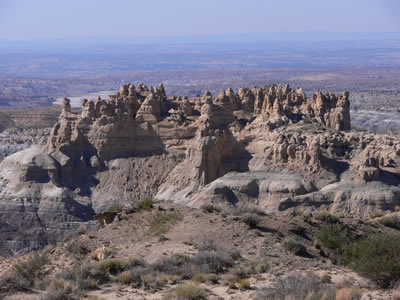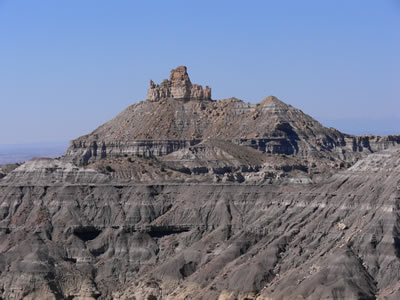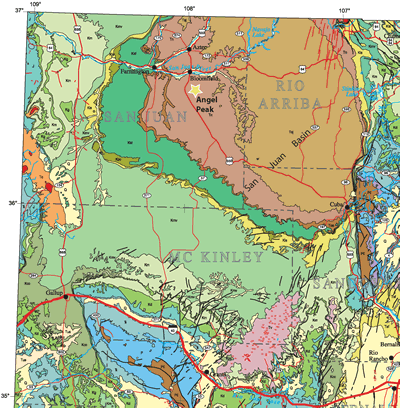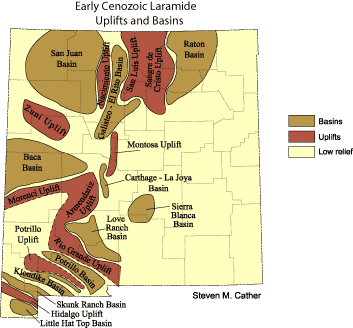
Angel Peak National Recreation Area
Location and Facilities

Angel Peak, a 7000-foot pinnacle capped by sandstone, is a prominent landmark near Bloomfield in northwestern New Mexico (Figure 2 ). Angel Peak National Recreation Area is located about 20 miles south of Bloomfield and can accessed via U.S. Highway 550. The turnoff to a well-maintained gravel road that leads east of Highway 550 to the recreation site is located about 0.25 miles south of mile marker 137 on U.S. Highway 550. A spectacular overlook of badlands cut onto maroon, gray, and yellow mudstone and sandstone awaits the visitor about 5.8 miles east of Highway 550. Sheltered picnic facilities and restrooms are located nearby. The Castle Rock overlook is 7.6 miles from the highway and the Cliffs Picnic area is 8.8 miles from the Highway 550 intersection (Figures 1 and 3). The Angel Peak Campground is 10.9 miles east of Highway 550 (Figure 4). Camping is free. Picnic tables, toilets, and fire rings are available at each camp site. You have to provide your own water and haul out your own trash. A short (<0.2 mile) Nature Trail on the west side of the campground offers nice views.


Regional Geologic Setting


Angel Peak National Recreation Area lies in the northern part of the San Juan Basin (Figure 5 and 6), a large structural depression that formed starting about 75 million years ago during compressional Laramide deformation (Cather, 2004). The San Juan Basin was surrounded by mountainous uplifts to the north (now buried by the 35 to 20 Ma San Juan volcanic field in southwestern Colorado) and to the east that also formed by Laramide-related compression. The sediments that can be seen at Angel Peak National Recreation area were eroded off of the old Laramide highlands and deposited in the basin 50 to 65 million years ago. More recently, over the course of the last 5 million years (or less), the westward-draining San Juan River, a tributary to the Colorado River, has eroded the rocks of the San Juan Basin. Drainages feeding into the San Juan River have carved the scenic landscape we see today.
Stratigraphy
Only two rocks units, the Paleocene Nacimiento Formation, and the Eocene San Jose Formation are visible at the surface in this area. The Nacimiento Formation is composed of shale, mudstone, and fine sandstone derived largely from erosion of Cretaceous rocks from the rising Laramide highlands (Figure 2; Baltz, 1967). The basal sandstone of the Eocene San Jose Formation (Cuba Mesa Member) disconformably rests on the fine-grained deposits of the Nacimiento Formation (Figures 3 and 4), although the amount of time missing at the contact is poorly constrained (Cather, 2004; Smith and Lucas, 1991, Smith, 1992a and b). South-flowing Eocene rivers deposited the San Jose Formation.
References
- Baltz, E.H., 1967, Stratigraphy and regional tectonic implications of part of Upper Cretaceous and Tertiary rocks, east-central San Juan Basin, New Mexico: U.S. Geological Survey Professional Paper 552, 101 pp.
- Cather, S.M., 2004, The Laramide orogeny in central and northern New Mexico and southern Colorado, in Mack, G.H., and Giles, K.A., eds., The Geology of New Mexico, A Geologic History: New Mexico Geological Society Special Publication 11, p. 203-248.
- Smith, L.N., 1992a, Upper Cretaceous and Paleogene stratigraphy and sedimentation adjacent to the Nacimiento Uplift, southeastern San Juan Basin, New Mexico: New Mexico Geological Society 43, p. 251-264.
- Smith, L.N., 1992b, Stratigraphy, sediment dispersal, and paleotopography of the Lower Eocene San Jose Formation, San Juan basin, New Mexico and Colorado: New Mexico Geological Society 43, p. 251-264.
- Smith L.N., and Lucas, S.G., 1991, Stratigraphy, sedimentology, and paleontology of the lower Eocene San Jose Formation in the west-central portion of the San Juan Basin, northwestern New Mexico: New Mexico Bureau of Mines and Mineral Resources Bulletin 125, 44 pp.
- Wilks, M.E., compiler, 2005, New Mexico Geologic Highway Map: New Mexico Geological Society and New Mexico Bureau of Geology and Mineral Resources, scale1:1,000,000.



